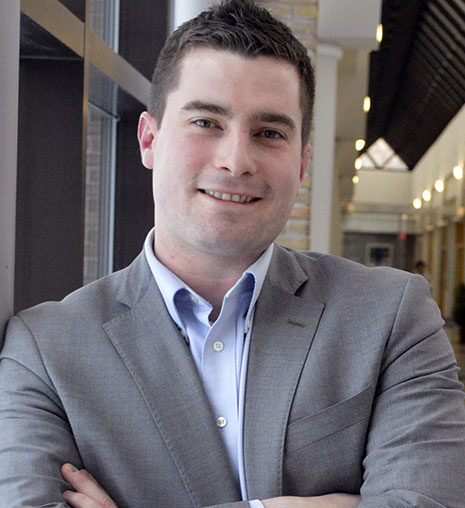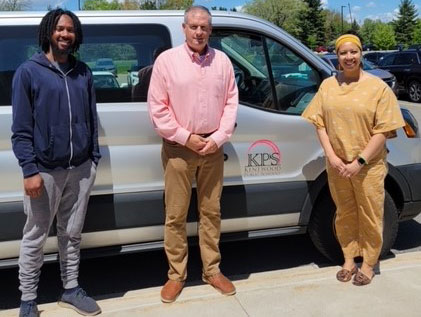Multiple districts – It was 3:30 p.m. on a Thursday afternoon, and the executive director of finance and business operations of one of the largest districts in Kent County was driving a van to bring students home from school.
Todd Bell gets behind the wheel when the Kentwood Public Schools transportation department is short on drivers. He shuttles students, who qualify as homeless and receive the service through the McKinney-Vento Act, to where they are living temporarily.
“I make some of my best budget decisions in the van here,” Bell joked. It’s also a nice break from routine, and he’s gotten to know the students he transports. “They start off quiet and they warm up. Some will tell you about their day.”
In the district of more than 9,000 students, staff members have taken on multiple roles and worn several hats to cover staffing needs this school year. Bus drivers are also working as custodians; teachers are adding tutoring and after-school programming to their schedules; and administrators, like Bell, are filling in where needed. “People are stepping up to the plate,” he said.
Like many industries, education has been hit hard by staff shortages that are impacting every facet of operations. Educators leaving the profession and fewer people entering it has created more demand for some positions, forcing Kent ISD schools to broaden their job postings geographically and offer more incentives. Plus, there’s increasing burnout after more than two years running schools in pandemic mode. With these factors all at play, schools are struggling to find enough bus drivers, food service workers, counselors, social workers and teachers.
“Throughout the pandemic, we’ve continued to lose people within the field of education,” said Chris Glass, Kent ISD director of legislative affairs and organizational and community initiatives. “We couple that with the fact that a district like Grand Rapids Public Schools has 240 positions open; we couple that with if you go on education job posting websites, there’s open positions after open positions.”
Noted Adriana Almanza, talent development, retention and diversity recruitment manager for GRPS, “The COVID reset is really exposing folks to a lot of opportunities that they probably weren’t looking for beforehand, like working from home, more flexibility.
“Historically, K-12 districts were competing with other K-12 districts for talent. Now we have to think more broadly. Now we are not only competing with other districts, we are competing with other industries.”

The Money’s There. Are the Workers?
Tutoring, support services, counselors, salary increases, pay incentives and new programming are top areas in which districts are spending $264.15 million from three allocations of federal Elementary and Secondary School Emergency Relief Funds, spread across Kent County.
While allocations per district vary greatly depending on the number of students who qualify as financially disadvantaged, all districts are receiving at least $1,093 per student in ESSR funds. Deadlines for the funds to be spent are September of 2022, September of 2023 and September of 2024.
Those federal funds, plus an increase in per-pupil funding from the state, mean districts face an interesting irony: “We probably have more resources than ever before, and yet we don’t have the pipeline there for districts to put these folks in place to meet the needs of all students,” Glass said.
Glass, who tracks legislation in Lansing, said factors playing a role in staff shortages in education aren’t only pandemic-related. They include the retirement of Baby Boomers and the fact that fewer people are seeking education degrees. The profession faced cuts and layoffs to balance tight budgets for many years.
“Because there was a lack of financial support for some of these key positions for so many years, people weren’t going into these fields because they weren’t going to be successful in securing employment,” Glass said.
Some positions are vastly harder to fill than others, he said. “In the area of mental health support – counselors, social workers, psychologists – those have been incredibly challenging.”
‘We probably have more resources than ever before, and yet we don’t have the pipeline there for districts to put these folks in place to meet the needs of all students.’
– Chris Glass, Kent ISD director of legislative affairs
Discussion is picking up in Lansing about ways to rebuild and replenish pipelines for teachers and support staff, he said. In her proposed budget, Gov. Gretchen Whitmer has included funds for scholarships for people going into teaching and resources to compensate student teachers at $9,600 per semester. A bill to establish a grant program to pay student teachers and their teaching mentors also is headed to the state House for a vote.
Other proposed investments include grow-your-own programs to help staff members, such as paraprofessionals, earn credentials to become teachers through higher-education programs. Also, to keep teachers from leaving the profession, Whitmer’s budget proposes funds for mentorship opportunities for new teachers as well as educator bonuses.

Dwindling Candidate Pools, Retention Challenges
Kentwood’s Bell said hiring is continuous for after-school programming and tutoring needed to help students catch up and stay on track.
“The district has been successful in filling these positions; however, the nature of these positions (16-20 hours per week) means there is a lot of turnover,” he said. “It is common to hire individuals in these roles who are finishing up college programs, then take this experience into their next careers.”
Kentwood is hoping to staff summer programming with its own teachers. Noted Bell: “We plan for a robust summer school program and after-school programming. We are offering them the opportunity, and many have taken us up on it. We are able to use the federal funds to entice them and make that worth their while.”

It’s been all hands on deck in Byron Center Public Schools as well, with teachers subbing for other teachers, food service workers helping as crossing guards – everyone stepping up, said Assistant Superintendent Jeff Wierzbicki, who is also working double duty as interim principal at Marshall Elementary.
“In Byron Center we’ve definitely felt the (staffing shortage),” Wierzbicki said. “It’s been difficult for us to fill some positions this year.”
In terms of support staff positions, he added, “We’ve definitely seen the pool not near as large as it has been in the past.”
After a bump in retirements last year, Wierzbicki is hoping the district doesn’t see high turnover moving forward. The number of applicants for teaching positions has dwindled. For an elementary teaching job that used to receive more than 100 applicants, they now get in the 20s or 30s. More specialized positions and special education receive even fewer, he said.
The district has been looking outside of Kent County more often, working to attract professionals from a broader geographical area and even utilizing virtual job fair opportunities outside the state.
Byron Center had already added staff members to address social-emotional needs pre-COVID. “We’ve definitely worked hard in growing our social workers, counselors and nurses,” Wierzbicki said. Still, “We’ve noticed when we are going through the pool (of applicants), it hasn’t been nearly as (deep as) in the past.”
They’ve also worked to partner with outside mental health services, but they are facing more demand than facilities can handle as well.

Openings Span Many Areas
Almanza said GRPS, the county’s largest district, regularly has 230 to 240 positions open for teachers, support staff and administrators. “It’s really across the board for us,” she said.
Teachers leaving due to the pandemic has impacted the profession nationwide, she said: “COVID hit all sectors, but the burden on the education system and what that meant and means for burnout and exhaustion in a school district was really amplified.”
Teaching-wise, positions have been especially difficult to fill in special education and math, while support staff shortages span departments. “Food service workers, custodians, grounds (workers), child care workers and paraprofessionals have been a really big challenge for us. We know it takes everybody across the district staff-wise to make a fully functioning district.”
In the area of mental health, social workers, counselors and mental health clinicians have all had vacancies throughout the year, and for summer programming many positions are still available. “We started recruiting for summer positions in early March, and many of those positions are still live for our summer teaching vacancies and other support staff,” Almanza said.
Looking ahead and facing a shrinking pool of teaching candidates, recruitment and retention efforts are multi-pronged, she said. GRPS is beginning to offer a $10,000 student teacher stipend using ESSR funds. And partnerships with local colleges and universities including Davenport and Grand Valley State universities are allowing current employees, such as parapros, to continue their education to receive a teaching license and receive tuition reimbursement.
‘Historically, K-12 districts were competing with other K-12 districts for talent. Now we are not only competing with other districts, we are competing with other industries.’
– Adriana Almanza, GRPS talent development, retention and diversity recruitment manager
Also, they are working to build their own pipeline with grow-your-own programs such as Teach Club. “We are really investing in our own middle- and high-school students and introducing them to education as a profession early on,” she said. “We are creating programs where they can leave us to go to an institution of higher education and return to teach.”
The district also works closely with nonprofits such as Hispanic-serving institutions, Historically Black Colleges and Universities and Native American colleges and universities for candidates.
Picking up extra duties and responsibilities has been common in GRPS this year as well. “We have had to pull some of our administrators into the classrooms to help teach and take over other programming,” Almanza said. “Our current staff needs to be praised for going above and beyond what their duties are in their sole job description because, really, it does take a team effort.”










